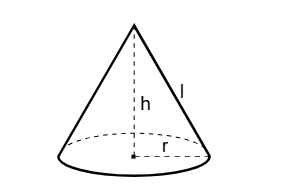1. What is a Cone Calculator?
Definition: This calculator computes the slant height (\( l \)), lateral surface area (\( A_L \)), total surface area (\( A \)), base area (\( A_B \)), and volume (\( V \)) of a cone, given the radius (\( r \)) and height (\( h \)). A cone is a three-dimensional shape with a circular base and a single vertex.
Purpose: It aids in geometry education, engineering, and design by providing measurements for cones, useful for calculating material needs, storage capacities, or structural properties.
2. How Does the Calculator Work?
The calculator uses the following formulas:
- Slant height \( l \): \( l = \sqrt{r^2 + h^2} \).
- Lateral surface area \( A_L \): \( A_L = \pi \cdot r \cdot l \).
- Base area \( A_B \): \( A_B = \pi \cdot r^2 \).
- Total surface area \( A \): \( A = A_L + A_B = \pi \cdot r \cdot l + \pi \cdot r^2 \).
- Volume \( V \): \( V = \frac{1}{3} \cdot \pi \cdot r^2 \cdot h \).
Unit Conversions:
- Length Units: m, cm (1 m = 100 cm), mm (1 m = 1000 mm), in (1 m = 39.3701 in), ft (1 m = 3.28084 ft), yd (1 m = 1.09361 yd).
- Area Units: m², cm² (1 m² = 10000 cm²), mm² (1 m² = 1000000 mm²), in² (1 m² = 1550.0031 in²), ft² (1 m² = 10.7639 ft²), yd² (1 m² = 1.19599 yd²).
- Volume Units: m³, cm³ (1 m³ = 1000000 cm³), mm³ (1 m³ = 1000000000 mm³), in³ (1 m³ = 61023.7441 in³), ft³ (1 m³ = 35.3147 ft³), yd³ (1 m³ = 1.30795 yd³).
Steps:
- Input the radius \( r \) and height \( h \), selecting their units.
- Validate inputs: Both must be positive.
- Convert inputs to meters for calculations.
- Compute the slant height, lateral surface area, base area, total surface area, and volume using the formulas above.
- Convert outputs to the selected units.
- Format outputs to 4 decimal places or scientific notation for small values.
3. Importance of Cone Calculations
Calculating the properties of a cone is crucial for:
- Geometry Education: Understanding three-dimensional shapes and their properties.
- Engineering and Design: Designing conical structures, such as funnels, silos, or traffic cones.
- Manufacturing: Determining material requirements or storage capacities for conical containers.
4. Using the Calculator
Examples:
- Example 1: Radius \( r = 3 \, \text{cm} \), Height \( h = 4 \, \text{cm} \)
- Convert: \( r = 0.03 \, \text{m} \), \( h = 0.04 \, \text{m} \).
- Slant height: \( l = \sqrt{0.03^2 + 0.04^2} = \sqrt{0.0009 + 0.0016} = 0.05 \, \text{m} = 5.0000 \, \text{cm} \).
- Lateral surface area: \( A_L = \pi \cdot 0.03 \cdot 0.05 \approx 0.0047 \, \text{m}^2 = 47.1239 \, \text{cm}^2 \).
- Base area: \( A_B = \pi \cdot 0.03^2 \approx 0.0028 \, \text{m}^2 = 28.2743 \, \text{cm}^2 \).
- Surface area: \( A = 0.0047 + 0.0028 \approx 0.0075 \, \text{m}^2 = 75.3982 \, \text{cm}^2 \).
- Volume: \( V = \frac{1}{3} \cdot \pi \cdot 0.03^2 \cdot 0.04 \approx 0.0000377 \, \text{m}^3 = 37.6991 \, \text{cm}^3 \).
- Example 2: Radius \( r = 2 \, \text{m} \), Height \( h = 3 \, \text{m} \)
- Slant height: \( l = \sqrt{2^2 + 3^2} = \sqrt{13} \approx 3.6056 \, \text{m} \).
- Lateral surface area: \( A_L = \pi \cdot 2 \cdot 3.6056 \approx 22.6546 \, \text{m}^2 \).
- Base area: \( A_B = \pi \cdot 2^2 \approx 12.5664 \, \text{m}^2 \).
- Surface area: \( A = 22.6546 + 12.5664 \approx 35.2210 \, \text{m}^2 \).
- Volume: \( V = \frac{1}{3} \cdot \pi \cdot 2^2 \cdot 3 \approx 12.5664 \, \text{m}^3 \).
5. Frequently Asked Questions (FAQ)
Q: What is a cone?
A: A cone is a three-dimensional shape with a single circular base and a vertex, where the slant height connects the vertex to the edge of the base.
Q: Why is the slant height calculated?
A: The slant height is calculated using \( l = \sqrt{r^2 + h^2} \) and is critical for determining the lateral surface area, which represents the curved surface of the cone.
Q: How is the volume of a cone derived?
A: The volume formula \( V = \frac{1}{3} \cdot \pi \cdot r^2 \cdot h \) is derived from the fact that a cone’s volume is one-third that of a cylinder with the same base and height.
 Home
Home
 Back
Back
